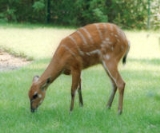
Tragelaphus
Encyclopedia
The genus
Tragelaphus contains several species of bovine, all of which are relatively antelope
-like. Species in this genus tend to be large sized, lightly built, have long necks and considerable sexual dimorphism
. The Common Eland
(Taurotragus oryx) was once classified in this genus as T. oryz. The name "Tragelaphus" comes from the mythical tragelaph
.
Genus
In biology, a genus is a low-level taxonomic rank used in the biological classification of living and fossil organisms, which is an example of definition by genus and differentia...
Tragelaphus contains several species of bovine, all of which are relatively antelope
Antelope
Antelope is a term referring to many even-toed ungulate species indigenous to various regions in Africa and Eurasia. Antelopes comprise a miscellaneous group within the family Bovidae, encompassing those old-world species that are neither cattle, sheep, buffalo, bison, nor goats...
-like. Species in this genus tend to be large sized, lightly built, have long necks and considerable sexual dimorphism
Sexual dimorphism
Sexual dimorphism is a phenotypic difference between males and females of the same species. Examples of such differences include differences in morphology, ornamentation, and behavior.-Examples:-Ornamentation / coloration:...
. The Common Eland
Common Eland
The common eland , also known as the southern eland or eland antelope, is a savannah and plains antelope found in East and Southern Africa. It is the largest antelope in the African continent...
(Taurotragus oryx) was once classified in this genus as T. oryz. The name "Tragelaphus" comes from the mythical tragelaph
Hircocervus
The hircocervus or tragelaph , also known as a goat-stag or horse-stag, was a legendary creature imagined to be half-goat, half-stag...
.
Species
- Genus Tragelaphus:
- BongoBongo (antelope)The western or lowland bongo, Tragelaphus eurycerus eurycerus, is a herbivorous, mostly nocturnal forest ungulate and among the largest of the African forest antelope species....
(Tragelaphus eurycerus) - Greater KuduGreater KuduThe Greater Kudu is a woodland antelope found throughout eastern and southern Africa. Despite occupying such widespread territory, they are sparsely populated in most areas, due to a declining habitat, deforestation and hunting....
(Tragelaphus strepsiceros) - Imbabala (Tragelaphus sylvaticus) see BushbuckBushbuckThe bushbuck is the most widespread antelope in Sub-Saharan Africa, and is found in rain forests, montane forests, forest-savanna mosaics and bush savannaforest and woodland. Recently, genetic studies have shown that the bushbuck, is in fact a complex of two geographically and phenotypically...
- KéwelKéwelThe Kéwel is a small to medium sized antelope widespread in west and central Africa. Formerly and alongside the Imbabala it was generically known as the bushbuck, however, it has since been found to be a species in its own right, with a separate geographic distribution...
(Tragelaphus scriptus) - Lesser KuduLesser KuduThe lesser kudu is a forest antelope found in East Africa and the southern Arabian Peninsula. The southern lesser kudu is a subspecies found in Kenya and Tanzania....
(Tragelaphus imberbis) - Mountain NyalaMountain NyalaThe Mountain Nyala found in Oromia, Ethiopia as gadumsa, is an antelope found in high altitude woodland in a small part of central Ethiopia...
(Tragelaphus buxtoni) - NyalaNyalaThe Nyala is a Southern African antelope. It is a spiral-horned dense-forest antelope that is uncomfortable in open spaces and is most often seen at water holes. Nyalas live alone or in small family groups of up to 10 individuals.The male stands up to 110 cm , the female is up to 90 cm ...
(Tragelaphus angasii) - SitatungaSitatungaThe situtunga or marshbuck is a swamp-dwelling antelope found throughout Central Africa, centering on the Democratic Republic of the Congo, Cameroon and parts of Southern Sudan as well as in Ghana, Botswana, Zambia, Gabon, Tanzania, Uganda and Kenya.-Description:Situtunga stand about one and a...
(Tragelaphus spekeii)
- Bongo

